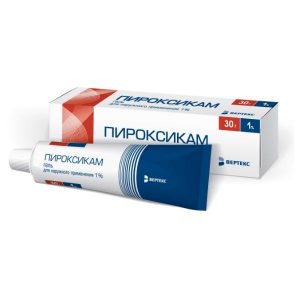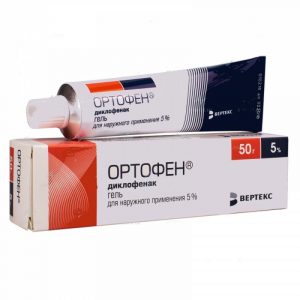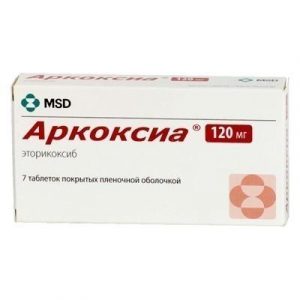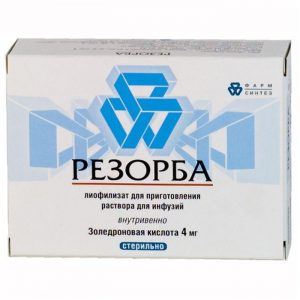Description
Release form
concentrate for solution for infusion
Packaging
Bottle 6 ml.
Pharmacological action
Pharmacological action – inhibiting bone resorption.
Pharmacodynamics
Bone resorption inhibitor, nitrogen-containing bisphosphonate. It has a specific selective effect on bone tissue due to its high affinity for the mineral components of bone. Suppresses the activity of osteoclasts, reduces the frequency of skeletal complications in malignant diseases.
Ibandronic acid reduces the osteoclast-associated release of tumor growth factors, inhibits the spread and invasion of tumor cells, and exhibits a synergistic effect with taxanes in vitro. Ibandronic acid prevents bone destruction caused by blockade of the function of the gonads, retinoids, tumor processes or the introduction of extracts of tumor tissue in vivo.
In doses significantly exceeding pharmacologically effective, ibandronic acid does not affect bone mineralization.
In case of hypercalcemia, the inhibitory effect of ibandronic acid on tumor-induced osteolysis and, in particular, on hypercalcemia associated with the tumor process, is accompanied by a decrease in serum calcium and urinary calcium excretion. In most cases, blood calcium levels normalize within 4 7 days after drug administration. The median time to a repeated increase in serum albumin-corrected calcium to 3 mmol / L is 18 26 days.
Ibandronic acid prevents the development of new and reduces the growth of existing bone metastases, which leads to a decrease in the frequency of skeletal complications, the intensity of the pain syndrome, the need for radiation therapy and surgical interventions for the metastatic process in the bones, thereby leading to a significant improvement in the quality of life of patients.
Ibandronic acid dose-dependently inhibits tumor osteolysis, as determined by bone resorption markers (pyridinoline and deoxypyridinoline).
Pharmacokinetics
Absorption.
After oral administration, ibandronic acid is rapidly absorbed in the upper gastrointestinal tract. The time to reach the maximum concentration (Tmax) is 0.5 2 hours (median – 1 hour) after fasting, the absolute bioavailability is 0.6%. The simultaneous intake of food or drink (except for pure water) reduces the bioavailability of ibandronic acid by 90%. Eating food or drinks 30 minutes after ibandronic acid reduces its bioavailability by 30%. When taking ibandronic acid 60 minutes before a meal, a significant decrease in bioavailability is not observed.
The plasma concentration of ibandronic acid increases in proportion to the dose administered intravenously (at a dose of up to 6 mg) or taken orally (at a dose of 100 mg).
The bioavailability of ibandronic acid is reduced to 75% when taken 2 hours after a meal, and therefore it is recommended that Bondronate tablets be taken on an empty stomach with a subsequent meal no earlier than 30 minutes.
distribution.
After entering the systemic circulation, ibandronic acid binds quickly in bone tissue or is excreted in the urine. The apparent final distribution volume is 90 liters. Communication with plasma proteins – 87%.
Metabolism.
There is no evidence that ibandronic acid is metabolized.
Withdrawal.
40-50% of the amount of the drug circulating in the blood penetrates and accumulates in the bone tissue, the remaining drug is excreted unchanged by the kidneys. Non-absorbable preparation after oral administration is excreted unchanged with feces.
Terminal T1 / 2 10-60 hours. The concentration of the drug in the blood decreases rapidly and reaches 10% of the maximum 3 hours after iv administration and 8 hours after oral administration.
With iv administration of ibandronic acid with an interval of 4 weeks for 48 weeks in patients with metastatic bone lesions, systemic cumulation was not observed.
The total clearance of ibandronic acid is 84 160 ml / min. Renal clearance (60 ml / min in healthy menopausal women) accounts for 50-60% of the total clearance and depends on the creatinine clearance. The difference between total and renal clearance reflects the uptake of the substance in the bone tissue.
Pharmacokinetics in special patient groups
The pharmacokinetics of ibandronic acid is not dependent on gender. There were also no clinically significant interracial differences in the distribution of ibandronic acid in individuals of the South European and Asian races. There is not enough data regarding the Negroid race.
Patients with impaired renal function. The exposure of ibandronic acid in patients with various impaired renal function depends on creatinine clearance. After a single intravenous injection of 6 mg of ibandronic acid (15-minute infusion), the average AUC (0 24) is 14% higher in patients with mild renal impairment (mean Cl creatinine = 68, 1 ml / min) and 86% in patients with impaired renal function of moderate severity (average Cl creatinine = 41.2 ml / min) compared with healthy volunteers (average Cl creatinine = 120 ml / min). Mean Cmax does not increase in patients with mild renal impairment and increases by 12% in patients with moderate renal impairment. In patients with severe renal impairment (creatinine Cl <30 ml / min) who received the drug orally at a dose of 10 mg for 21 days, the concentration of ibandronic acid in blood plasma was 2-3 times higher than in patients with normal renal function. An increase in systemic concentration does not impair drug tolerance. However, patients with severe impaired renal function (Cl creatinine <30 ml / min) should reduce the dose to 1 tablet. 50 mg once a week. For patients with impaired renal function of mild or moderate severity (Cl creatinine 30 ml / min), dose adjustment for oral administration is not required. With iv administration, a change in the dose and time of infusion in patients with metastatic bone damage in breast cancer is required. During the standard 4-hour hemodialysis procedure, 37% of ibandronic acid is excreted from the body. Patients with impaired liver function. There are no data on the pharmacokinetics of ibandronic acid in patients with impaired liver function. The liver does not play a significant role in the clearance of ibandronic acid, which is not metabolized, but excreted through the kidneys or bound to bone tissue. In patients with impaired liver function, dose adjustment is not required. In addition, in therapeutic concentrations, ibandronic acid weakly binds to plasma proteins (87%), therefore, it is likely that hypoproteinemia in severe liver diseases does not lead to a clinically significant increase in the concentration of ibandronic acid in the blood. Old age. The studied pharmacokinetic parameters are independent of age. Possible impairment of renal function in elderly patients should be considered. Children: There are no data on the use of Bondronate in persons under 18 years of age. Contraindications hypersensitivity to ibandronic acid or other components of the drug childhood clinical experience) pregnancy and lactation. Caution: Cl creatinine <30 ml / min hypersensitivity to other bisphosphonates when taken orally – in combination with NSAIDs. Special instructions Monitor renal function, serum Ca2 + and Mg2 +. Do not inject in / a and s / c due to possible damage to surrounding tissues. Composition of ibandronic acid 1 mg in the form of sodium ibandronate monohydrate 1.125 mg excipients: sodium sodium chloride acetate acetic acid 99% water for injection Dosage and administration Bondronate in the form of a concentrate for the preparation of a solution for infusion is usually used in a hospital setting and is administered intravenously drip for 1-2 hours after preliminary dilution. The concentrate for the preparation of a solution for infusion is diluted in 500 ml of 0.9% sodium chloride solution or 5% dextrose solution. Side effects of When given on / in: fever, asthenia, headache sometimes – flu-like syndrome (fever, chills, ossalgia and myalgia), which in most cases do not require specific treatment and disappear after a few hours or days, hypersensitivity reactions are rare – dyspepsia, diarrhea, bronchospasm in patients with aspirin bronchial asthma. On the part of laboratory indicators: often – decreased calcium excretion by the kidneys, hypophosphatemia, which does not require therapeutic intervention, sometimes – hypocalcemia. When taken orally: the most frequently observed phenomena are dyspepsia and hypocalcemia. Very rarely, jaw osteonecrosis was observed with the administration of ibandronic acid. Drug interactions Aminoglycosides increase the risk of hypocalcemia. Chemically incompatible with calcium solutions. Storage conditions In a dry place, at a temperature not exceeding 30 ° C. Keep out of the reach of children. is valid for 5 years. Pharmacy terms Prescription Form of Treatment simply entails dlya infusing Appointment Adult prescription




